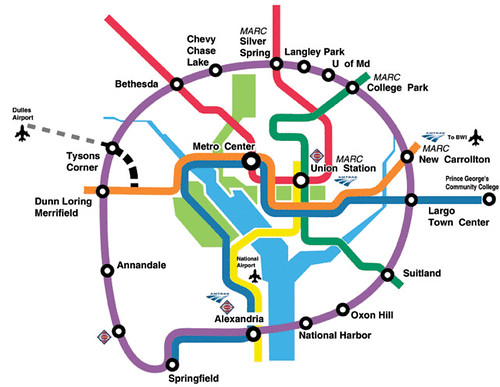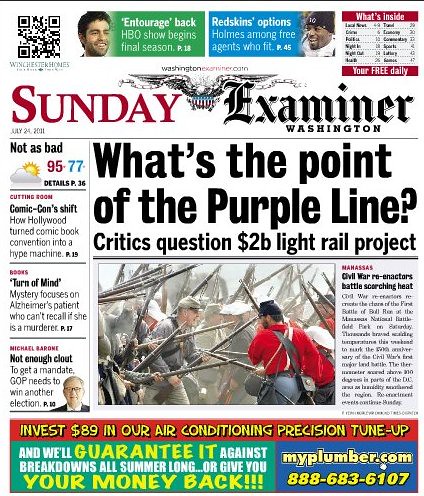Maybe the Purple Line light rail project in Suburban Maryland is a lot bigger deal than is recognized (It's our Crossrail)
-- "To build the Purple Line, perhaps Montgomery and Prince George's Counties will have to create a "Transportation Renewal District" and Development Authority," 2015
-- "Purple line planning in suburban Maryland as an opportunity to integrate place and people focused initiatives into delivery of new transit systems," 2014
-- "Quick follow up to the Purple Line piece about creating a Transportation Renewal District and selling bonds to fund equitable development," 2014
-- "Inner ring suburban community improvement," 2014
Granted the Purple Line light rail line that is being built in Montgomery and Prince George's Counties in Suburban Maryland isn't the full circumferential line proposed in a Washington City Paper cover story dating to December 1987.

For maximum benefit, the Purple Line needs to be extended westward from Bethesda to Fairfax County on the north and on the south westward from New Carrollton to National Harbor and Alexandria. Currently, no such planning is underway.
Even though it is a much smaller project than two major suburban transit expansion projects in London and Paris:
- Crossrail: a passenger rail program, much of it underground in new tunnels, with 73 miles of new track and 40 new stations, connecting a multitude of subway and rail lines across London and its suburbs, scheduled to be completed in 2019. (Proposals for Crossrail 2 and Crossrail 3 are being floated also);
- Grand Paris Express: this program will add four new subway lines and extend four others, providing suburb-to-suburb connections that don't current exist as well as better connections to the center city focused Metro and RER network of subway and commuter railroad service, simultaneously addng capacity to ease congestion on existing lines. The project will add 125 miles of track and 72 stations. It will open in stages, with completion expected in 2030.
-- "Mapping the Purple Line," Washington Post
The line will connect the east (Bethesda) and west (Silver Spring) legs of the Red Line to the northern leg of the Green/Yellow Lines (College Park), and the eastern terminus of the Orange Line (New Carrollton), along with connections to each of MARC commuter rail's three lines: Brunswick (at Silver Spring); Camden (at College Park); and the Penn Line (at New Carrollton).

Washington Post graphic.
It's not Crossrail or Grand Paris Express, but it's still a big deal--even though it won't be underground, is in mixed traffic, and will be slower.
It's a project that isn't given enough credit for its pathbreaking elements and opportunity to give a positive jump start to Metrorail given its current difficulties and will expand and connect the metropolitan transit network in significant ways.
It could even set the stage for some expansion of the MARC railroad passenger service ("One big idea: Getting MARC and Metrorail to integrate fares, stations, and marketing systems, using London Overground as an example").
 While I am always sorry to lose a newspaper, the Washington Examiner free daily constantly took positions against transit expansion--car companies are much bigger local advertisers than transit systems.
While I am always sorry to lose a newspaper, the Washington Examiner free daily constantly took positions against transit expansion--car companies are much bigger local advertisers than transit systems.Instead the line has been controversial for many reasons, too many to recount here.
With the extensions mentioned above, while light rail, the Purple Line could have comparable impacts to the Crossrail and Grand Paris Express projects, and the London Overground ("In the loop: How one railway line helped change the way Londoners commute," Economist).
Hopefully, as the Purple Line comes closer to reality it can spur proposals and planning for extension, comparable to how the Crossrail program is spawning similar proposals in other areas of Greater London.
-- Crossrail 2 | Supporting growth in the South east, Transport for London
-- "TfL takeover of London rail could be 'Crossrail 3' – Lord Adonis," Rail Technology Magazine
Similarly, RATP is improving the existing Paris transit system simultaneous with the Grand Paris Express program of expansion.
-- Métro 2030, our new Paris Metro, RATP
Adding intra-suburban service, even light rail, will boost Metrorail reliability. Elsewhere ("Redundancy, engineered resilience, and subway systems: Metrorail failures will increase without adding capacity in the core") I wrote that the Purple Line can have a significantly positive impact on Metrorail system reliability, for some of the same reasons that Crossrail and GPE will provide similar benefits, by providing suburb-to-suburb connections and additional options to transfer between lines without having to travel to the center city.
Images from East MoCo blog of the promotional Purple Line informational signage posted at the Silver Spring Library, which will be one of the stations for the line.
You could argue that by adding riders to the current system, it could add stress because of the failure to add capacity to the core.
However, by providing a missing east-west connection between the subway lines outside of Downtown DC, likely the Purple Line will "add capacity" by providing four new transfer points between subway lines, facilitating transfer between lines without requiring riders to go all the way to Downtown DC to do so, as is required today.
As a light rail system, it isn't compatible with Metrorail, so the lines won't "interline" the way that the Orange, Blue, and Silver Lines and the Green and Yellow Lines share tracks.
And as light rail, it has less capacity, able to move about 15,000 riders/hour, versus 25,000+ on subway lines. (Interlining reduces maximum capacity. Only the Red Line, which doesn't interline, can exceed 30,000 riders/hour per track.)
This is a beneficial feature because interlining reduces the capacity of any one line and often leads to service problems replicating like a virus across lines.
By comparison, adding the Silver Line to the Metrorail system appears to have been "the straw that broke the camel's back" in terms of leading to multiple, regular, and cascading failures across the system.
Labels: fixed rail transit service, suburban revitalization, transit and economic development, transit marketing, transportation planning, urban design/placemaking





5 Comments:
No, the Purple Line is not Crossrail. Not even close.
Crossrail is a relatively small capital project that will add tremendous value to existing rail assets and transform them into higher capacity rapid transit.
The Purple Line is not that, at all. It's a good project, but it has more in common with Parisian tramways than Crossrail or the Grand Express.
True, true. But it's still a bigger deal than it is given credit for. But there is no question it pales by comparison to London or Paris.
again, while it would still not be comparable, were more of the concept to be executed, e.g., as I suggest above, it would be a much bigger deal.
I'd have to say Alex B's points are strong here, much more like the Paris Tram.
As you said in other post, don't let a crisis go to waste, WMATA falling apart is really a chance to re-think how to do all transit in the region.
The RATP webpage is a marvel.
The Metro 2030 program is being funded at 500M euro a year, which is probably less than DC is spending.
I am very enjoyed for this blog. I feel strongly about it and love learning more on this topic. If possible, as you gain expertise, would you mind updating your blog with more information? It is extremely helpful for me Get More Information About Logistics Visit:
List of Logistics Companies in Bangalore | Logistics Services in Bangalore | Project Logistics Companies in India
Post a Comment
<< Home